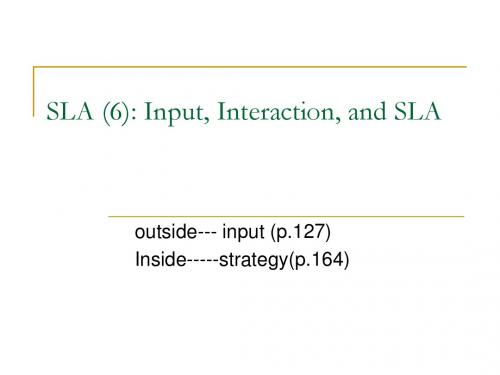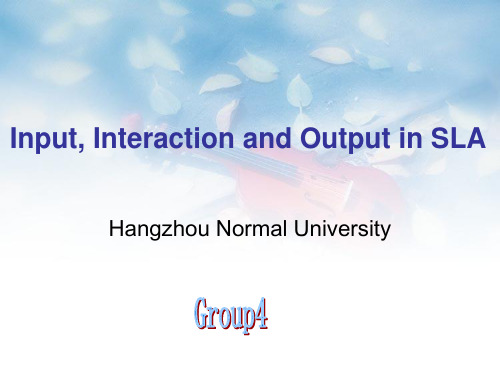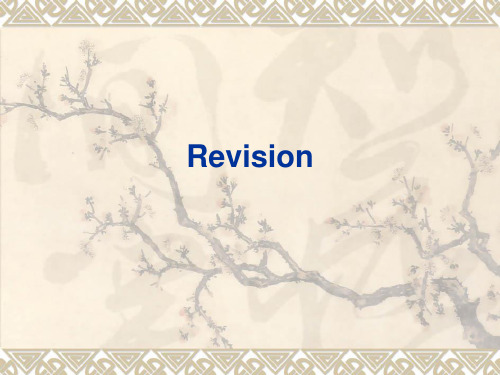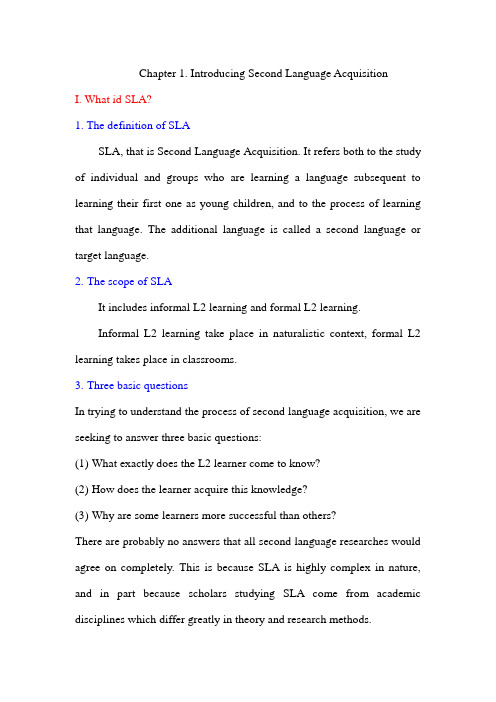Input and interaction (SLA)
- 格式:ppt
- 大小:167.50 KB
- 文档页数:98






Chapter 1. Introducing Second Language AcquisitionI. What id SLA?1. The definition of SLASLA, that is Second Language Acquisition. It refers both to the study of individual and groups who are learning a language subsequent to learning their first one as young children, and to the process of learning that language. The additional language is called a second language or target language.2.The scope of SLAIt includes informal L2 learning and formal L2 learning.Informal L2 learning take place in naturalistic context, formal L2 learning takes place in classrooms.3.Three basic questionsIn trying to understand the process of second language acquisition, we are seeking to answer three basic questions:(1)What exactly does the L2 learner come to know?(2)How does the learner acquire this knowledge?(3)Why are some learners more successful than others?There are probably no answers that all second language researches would agree on completely. This is because SLA is highly complex in nature, and in part because scholars studying SLA come from academic disciplines which differ greatly in theory and research methods.II. What is a second Language?A second language is typically an official or societally dominant language needed for education, employment, and other basic purposes.A foreign language is one not widely used in the learners' immediate social context which might be used for further travel or other cross-cultural communication situations, or studied as a curricular requirement or elective in school, but with no immediate or necessary practical application.A library language is one which functions primarily as a tool for further learning through reading, especially when books or journals in a desired field of study are not commonly published in the learners' native tongue.An auxiliary language is one which learners need to know for some official functions in their immediate political setting, or will need for purposes of wider communication, although their first language serves most other needs in their lives.III. What is a first language?Acquisition of more than one language during early childhood is called simultaneous multilingualism.Sequential multilingualism: learning additional languages after L1.IV. Diversity in learning and learnersWhat is learned in acquiring a second language, as well as how it islearned is often influenced by whether the situation involves informal exposure to speakers of other languages, immersion in a setting where one needs a new language to meet basic needs, or formal instruction in school, and these learning conditions are often profoundly influenced by powerful social, cultural, and economic factors affecting the status of both languages and learners.Chapter 2 Foundations of Second Language AcquisitionI. The world of second languageNot only is bilingualism worldwide, it is a phenomenon that has existed since the beginning of language in human history. It is probably true that no language group has ever existed in isolation from other language groups. There are many more bilingual or multilingual individuals in the world than there are monolingual.Multilingualism refers to the ability to use two or more languages.Monolingualism refers to the ability to use only one.Those who grow up in a multilingual environment acquire multilingual competence in the natural course of using two or more languages from childhood with the people around them, and tend to regard it as perfectly normal to do so. Adding second languages at an older age often takes considerable effort, however, and thus requires motivation. This motivation may arise from a variety of conditions, including the following:(1)invasion or conquest of one's country by speakers of another language;(2)A need or desire to contact speakers of other languages in economic or other specific domains;(3)Immigration to a country where use of a language other than one's another language;(4)Adoption of religious beliefs and practices which involve use of another language.(5)A need or desire to pursue educational experience s where access requires proficiency in another language;(6)A desire for occupational or social advancement which is furthered by knowledge of another language;(7)An interest in knowing more about peoples of other cultures and having access to their technologies or literatures.II. Reasons for uncertainty in reporting language data include some which have social and political significance, and some which merely reflect imprecise or ambiguous terminology, for example:1.Linguistic information is often not officially collected2.Answers to questions seeking linguistic information may not be reliable3.There is lack of agreement on definition of terms and on criteria for identificationIII. The nature of language learningBy the age of six months an infant has produced all of the vowel sounds and most of the consonant sounds of any language in the world.On average children have mastered most of the distinctive sounds of their first language before they are three years old, and an awareness of basic discourse patterns such as conversational turn-taking appear at aneven earlier age. Children control most of the basic L1 grammatical patterns before they are five or six, although complex grammatical patterns continue to develop through the school years.The understanding of how children accomplish the early mastery of L1has changed radically in the past fifty years or so. (1). It was suggested that first language acquisition is in larger part the result of children's natural desire to please their doting parents. (2). Others argued that children's language acquisition is purposive, that they develop language because of their urge to communicate their wants and needs to the people who take care of them. (3). The most widely held view by the middle of the twentieth century was that children learn language by imitation .IV. The role of natural abilityHumans are born with a natural ability or innate capacity to learn language. In viewing the natural ability to acquire language in terms of innate capacity, we are saying that part of language structure is genetically "given" to every human child. If a child had to consciously learn the set of abstract principles that indicate which sequences of words are possible sentences in their language as opposed to those that are not, only the smartest would learn to talk, and it would take them many more years than it actually does.V. The role of social experienceEven if the universal properties of language are preprogrammed inchildren, they must learn all of those features which distinguish their L1 from all other possible human languages. Appropriate social experience , including L1 input and interaction, is thus a necessary condition for acquisition.Sources of L1 input and interaction vary depending on cultural and social factors. Mother's talk is often assumed to be the most important source of early language input to children. The relative importance of input from other young children also varies in different cultures, as does the importance of social institutions such as nursery schools.When young children's social experience includes people around them using two or more languages, they have the same innate capacity to learn both or all of them.VI. L1 versus L2 learningThis brief comparison of L1 and L2 learning is divided into three phases. The first is the initial state, which many linguists ans psychologists believe includes the underlying knowledge about language structures and principles that is in learner's heads at the very start of L1or L2 acquisition. The second phase, the intermediate states, covers all stages of basic language development. The third phase is the final state, which is the outcome of L1and L2 learning.(1). Initial stateSome linguists and psychologists believe that the genetic predispositionwhich children have from birth to learn language remains with them throughout life, and that differences in the final outcomes of L1and L2 learning are attributable to other factors. Others believe that some aspects of the innate capacity which children have for L1 remain in force for acquisition of subsequent languages, but that some aspects of this natural ability are lost with advancing age.There is complete agreement , however, that since L2 acquisition follows L1 acquisition , a major component of the initial state for L2 learning must be prior knowledge of L1.(2).Intermediate statesThere is similarity in that the development of both L1and L2 is largely systematic, including predictable sequencing of many phenomena within each and some similarity of sequencing across languages, and in the fact that L1and L2 learners both play a creative role in their own language development and do not mimic what they have heard or been taught. ·processes·necessary conditions·facilitating conditions(3)final stateThe final state is the outcome of L1or L2 learning . The final state of L1development is native linguistic competence. While vocabulary learning and cultivation of specialized registers may continue intoadulthood,the basic phonological and grammatical systems of whatever languages children hear around them re essentially established by the age of about five or six years , along with vocabulary knowledge and interaction skills that are adequate for fulfilling communicative functions. VII. The logical problem of language learningThe "problem" as it has been formulated by linguists relates most importantly to syntactic phenomena. As noted in the preceding section, most linguists ans psychologist assume this achievement must be attributed to innate and spontaneous language-learning construct and/or process. The notion that innate linguistic knowledge must underline language acquisition. This view has been supported by arguments such as the following:1.Children's knowledge of language goes beyond what could be learned from the input they receiveThis is essentially the poverty -of- the- stimulus argument. According to this argument, children often hear incomplete or ungrammatical utterances along with grammatical input,and yet they are somehow able to filter the language they hear so that the ungrammatical input is not incorporated into their L1 system.2.Constrains and principles cannot be learnedConstrains ans principles cannot be learned in part because children acquire a first language at an age when such abstractions are beyond theircomprehension; Constrains ans principles are thus outside the realm of learning processes which are related to general intelligence.3.Universal patterns of development cannot be explained by language-specific inputThe extent of this similarity suggests that language universals are not only constructs derived from sophisticated theories and analyses by linguists, but also innate representations in every young child's mind. The logical problem of language learningFirst of all, children often say things that adults do not.Next, children use language in accordance with general universal rules of language even though they have not yet developed the cognitive ability necessary to understand these rules.Finally, patterns of children's language development are not directly determined by the input they receive.VIII. Frameworks for SLAFrameworks for study of SLATimeline linguistic psychological social195os and before structuralism behaviorism sociocultural theory 1960s TGG neurolinguistics information processing ethnography of communication variation theory1970s functionalism humanistic models acculturation theroy1980s principles and parameters model connectionism social psychology1990s minimalist program processabilityThis view is still influential in SLA approaches which are concerned with the role of input and interaction.1.linguisticThere have been two foci for the study fo SLA from a linguistic perspective since 1960:internal and external. The internal focus has been based primarily on the work of Noam Chomsky and his followers. It sets the goal of study as accounting for speakers' internalized, underlying knowledge of language rather than the description of surface forms as in earlier Structuralism. The external focus for the study of SLA has emphasized language use, including the functions of language which are realized in learners' production at different stages of development.2.PsychologicalThere have been three foci in the study of SLA from a psychological perspective: languages and the brain, learning processes and learner differences.Language and the brainThe location and representation of language in the brain has been of interest to biologists and psychologists since the nineteenth century. And the expanding field of Neurolinguistics was one of the first to influencecognitive perspectives on SLA when systematic study began in th e1960s.Learning processesThe focus on learning processes has been heavily influenced by computer-based Information Processing(IP) models of learning, which were established in cognitive psychology by the 1960s. Explanations of SLA phenomena based on this framework involve assumptions that L2 is a highly complex skill, and that learning L2 is not essentially unlike learning other highly complex skills.Learner differencesThe focus on learner differences in SLA has been most concerned with the question of why some learners are more successful than others. This framework calls for consideration of emotional involvement in learning, such as affective factors of attitude, motivation, and anxiety level.SocialThere are two foci for the study of SLA from this perspective:micro-social and macro-social.Micro-social focusThe concerns within the micro-social focus relate to language acquisition and use in immediate social contexts of production, interpretation and interaction.Macro-social focusThe concerns fo the macro-social focus relate language acquisition and use to broader ecological contexts, including cultural, political and educational settings.。
《应用语言学》课程教学大纲课程代码:ENGL2049课程类别:专业选修课授课对象:英语、英语师范专业开课学期:秋(第7学期)学分: 2主讲教师:王宇指定教材:1.《应用语言学》(第二版),乐眉云主编,南京师范大学出版社,2004年。
2.《第二语言习得研究与外语学习》,丁言仁,上海外语教育出版社,2004年。
教学目的(含课程内容和考核方式)应用语言学有狭义和广义之分。
狭义的应用语言学专指语言教学,特别是指第二语言教学或外语教学。
广义的应用语言学则涵盖所有与语言和语言学应用有关的学科,包括第二语言习得、社会语言学、心理语言学、神经语言学等等。
本课程将重点选取与学生英语学习密切相关的领域——即第二语言习得和第二语言教学——进行分析和讨论。
本课程是面向英语和英语教育专业所有学生的一门专业选修课,其教学目的为:●帮助学生了解第二语言习得和第二语言教学方面的基本理论和主要论题,培养学生的研究兴趣和一定的批评能力;●引导学生自觉地运用应用语言学原理指导和促进英语学习;●掌握基本的应用语言学研究方法,为撰写毕业论文打下基础。
本课程分三个模块,主要内容包括:模块一:第二语言习得,包括学习者语言/中介语、影响第二语言习得的外在因素、第二语言习得的内在机制、学习者个体差异、二语习得理论、课堂教学与第二语言习得等。
模块二:第二语言教学,包括语言技能(包括听、说、读、写)的教学和语言评估。
模块三:应用语言学的研究方法和论文写作。
考核方式:课堂讨论(20%),课外文献阅读(30%),以小组为单位的项目报告(50%)。
第一课 Orientation课时:第一周,共2课时教学内容:第一节What is applied linguistics?The Role of Applied LinguisticsThe Nature of Applied Linguistics第二节Why should we study applied linguistics?Applied Linguistics and the Language Teacher思考题:1.What is the relationship between Linguistics and applied linguistics:hierarchy or partnership?2.Can there be a unitary theory of applied linguistics, or indeed dotheories of applied linguistics exist at all?3.Should applied linguists be theoretical?模块一(第2课——第8课):Essential Concepts and Theories in SLA第二课 Puzzles in SLA & The Influence of Behaviorism课时:第二周,共2课时教学内容第一节SLA as a Field of LearningIssues for Exploration第二节The “Interference” of L1The behaviorist Understanding of SLAContrastive AnalysisCriticism from Empirical Research思考题:1.Think of more features on which students make errors sometimes butdo fairly well other times. Describe the conditions under which they tend to err and those under which they tend to get it correct.2.Think of a few areas of difficulty for advanced Chinese learners ofEnglish. Do there areas represent features that are overtly or slightly different from their Chinese counterparts?第三课 The “Chomskyan Revolution”课时:第三周,共2课时教学内容第一节Chomskyan LinguisticsCriticisms of Chomskyan Linguistics第二节Interlanguage HypothesisError analysis思考题:1.Give examples of errors young children make when they are learningto speak Chinese. You may recall the errors you yourself made when you were little.2.Sometimes sentences may look similar, but their functions can be verydifferent. Compare “Jack comes here”with “Here comes Jack.”What are their differences? Think of situations in which you can use one but not the other.第四课 Natural Order and comprehensible Input课时:第四周,共2课时教学内容第一节Natural Order HypothesisMorpheme Studies and Their findings第二节Problems with Error Analysis and Morpheme StudiesComprehensible Input Hypothesis思考题:1.If you know any international students or any other non-nativespeakers of Chinese, carefully observe their speech. Do they make errors that are similar to those you once made when you were a child?2.What are the flaws in Krashen’s Comprehensible Input Hypothesis?第五课 Variability in Performance and Acquisition课时:第五周,共2课时教学内容第一节Variability in L1 UseVariability in L2 Language Learner第二节Role of Variability in SLALearner Variation思考题:1.Discuss the possible reasons for the L2 performance variation foundin the Foster and Skehan study and Zhu Lingzhi’s study.2.Think of as many categories as you can that would characterize yourcurrent and former classmates, such as extroverts, introverts, bookworms, athletes, loners, born leaders, social butterflies, teachers’pets, to name a few. Discuss, in small groups, how different character traits affect language learning differently, and what traits are associated with good language learning and why.第六课 Input and Interaction课时:第六周,共2课时教学内容第一节Input and Interaction in L1 AcquisitionInput and Interaction in Natural SettingsInput and Interaction in Classroom SettingsEffects of Input and Interaction on SLA第二节Criticism of the Interaction HypothesisSwain’s Output HypothesisEmpirical Studies on the Role of Interaction思考题:1.In China, we use Chinese all the time, but we may still suddenly failto recall a term (or name of a person) we want to use. What do you do if this happens to you when you are (1) shopping, (2) visiting a university president, or (3) delivering a speech to a large audience?2.Recall one of your encounters with a person from overseas who was usingChinese as his or her L2. How soon did you become aware that this person might have trouble following you? What did you do to modify your speech so that you could be correctly understood?第七课 Learner Strategies课时:第七周,共2课时教学内容第一节Production StrategiesCommunication Strategies第二节Learning StrategiesThe Role of Memorization Strategies思考题:1.Presumably, production strategies will help us with production andcommunication, but will they also help us with L2 learning? Are there any strategies that do not facilitate our learning?2.Go over the list of cognitive strategies in Table 7.1 (P.167-170) again.Of the 15 strategies listed, how many of them have to do with understanding the auditory or printed material? How many of them have to do with memorizing words and phrases? How many of them have to do with learning and applying syntactic rules?第八课 Noticing the Native Speaker Selection课时:第八周,共2课时教学内容第一节The Noticing HypothesisEffects of the Noticing Hypothesis第二节Noticing the Native Speaker SelectionA New Model of Language思考题:1.How would you compare Schumann’s research with Schmidt’s? Which ofthem is closer to your own experience of learning English or another foreign language?2.Give an example of a situation in which you yourself succeeded inunderstanding or communication even though you did not have the necessary vocabulary.模块二(第9课——第13课):Language Skills and Assessment第九课 Listening课时:第九周,共2课时教学内容第一节What is listening?Issues in listening第二节How do we gain insights in listening?From Theory to Practice: Issues in Teaching L2 Listening思考题:1.What do you think are the difficulty factors in listening?2.In many Chinese ESL classrooms, teachers are mostly “testing”ratherthan teaching listening. What is your opinion about this phenomenon?What can the teachers do to “teach” the students how to listen?第十课 Speaking and Pronunciation课时:第十周,共2课时教学内容第一节What are Speaking and Pronunciation?Issues in SpeakingIssues in Pronunciation第二节Implications for Pedagogy思考题:1.Should speaking activities focus on texts or sentences?2.What procedures are there specifically for pronunciation teaching?第十一课 Reading课时:第十一周,共2课时教学内容第一节What is Reading?Reading in a Second LanguageL2 Reading vs L1 Reading第二节Issues in L2 ReadingImplications of L2 Research for Instruction思考题:1.Discuss the contributing role of vocabulary knowledge for L2 readingabilities.2.It is generally agreed that extensive reading should be a componentof almost any reading program. To what extent should extensive reading be balanced with an intensive reading program containing well-considered reading instruction (for example, in reading strategies, in vocabulary, etc.)?第十二课 Writing课时:第十二周,共2课时教学内容第一节Demystifying WritingAspects of Writing第二节Second Language Writing: Theory, Research, and Pedagogy思考题:ment on the three L2 writing approaches: controlled composition,the paragraph pattern approach and the process approach.第十三课 Assessment课时:第十三周,共2课时教学内容第一节What is Language Assessment?Fundamental Issues in Language Assessment第二节Language Assessment and Language Teaching思考题:1.Define the term “validity”.2.Discuss the relationship between language assessment and languageteaching.模块三(第十四周——第十八周): Research Methods and Thesis Writing第十四课 Research Methods in Applied linguistics课时:第十四周,共2课时教学内容第一节What is research?Developing research questionsSelecting research designs第二节A survey studyAn experimental studyA case study思考题:1.What tasks does a researcher have to accomplish if a piece of researchis conducted effectively?2.What are the important differences between quantitative andqualitative designs?第十五课 Writing Up a Research Report课时:第十五周,共2课时教学内容第一节The structure of a thesis / research reportWriting an introductionWriting a literature reviewDescribing methodologyReporting results and discussionWriting the conclusion chapter第二节Academic writing styleAPA writing format思考题:1.Try to get a copy of an undergraduate thesis or an MA thesis. Work witha group to comment on its structure, language, format, etc. Reading Week (第十六周)第十七课 Project Report (1)第十八课 Project Report (2)主要参考文献:1.《英语语言学纲要》,丁言仁、郝克,上海外语教育出版社,2001年。
Chapter 10 Language Acquisition语言习得一、本章纲要二、本章重点Language acquisition is concerned with language development in humans. In general, language acquisition refers to children’s development of their first language, that is, the native language of the community in which a child has been brought up. The development of a first or native language (L1)is called first language acquisition (FLA), and then second language acquisition (SLA). L1 and L2 development do not seem to involve identical processes. 语言习得关注的是人类语言能力发展。
语言习得一般指儿童母语的发展。
有些孩子除了习得母语外,还要继续习得第二语言或外国语。
习得母语或第一语言称为第一语言习得,除了母语再习得另一门语言或外语称为第二语言习得。
The study of language acquisition enables linguists, psychologists and applied linguists to better understand the nature of human language and developmental processes of language acquisition.1.First language acquisition第一语言习得Whatever their culture, all normal human beings acquire their native language at a given time of life and in an appropriate linguistic environment that provides sufficient language exposure.(2004, 2007, 判断) It is an established understanding among linguists that the capacity to acquire one’s first language is a fundamental human trait that all human beings are equally well possessed with.No one is more successful than others in acquiring a first language. Children follow a similar acquisition schedule of predictable stages along the route of language development across cultures, though there is an idiosyntactic variation in the amount of time that takes individuals to master different aspects of the grammar. 儿童在习得母语时虽然会有个性差异,但是正常儿童只要有正常的交际环境和正常的母语输入都可以成功地习得母语,他们习得母语的过程也非常相似。
二语习得引论读书笔记chapter1-2一.概论Chapter 1. Introducing SLA1.Second language acquisition (SLA)2.Second language (L2)(也可能是第三四五外语)also commonly called a target language (TL) Scopes Takes place in ExamplesInformal L2 learning Naturalistic contexts “pick up”Interacting Formal L2 learning Classes or courses ClassesL2 learning that involves a mixture of formal and informal learning Naturalistic contextscombined with Classesor coursesInteracting and learning inclasses at the same time3.Basic questions:1). What exactly does the L2 learner come to know2). How does the learner acquire this knowledge3). Why are some learners more successful than othersFields EmphasizeLinguists Characteristics of the differences and similarities in thelanguages that are being learned;The linguistic competence (underlying knowledge) andlinguistic performance (actual production).Psychologists and psycholinguists The mental or cognitive processes involved in acquisition; The representation of languages in the brain.Sociolinguists Variability in learner linguistic performance;Communicative competence (pragmatic competence).Social psychologists Group-related phenomena;The interactional and larger social contexts of learning.Applied linguists about SLA Any one or more perspectives above; Theory and research for teaching.4.linguistic; psychological; social.Only one (x) Combine (√)Chapter 2. Foundations of SLAⅠ. The world of second languages1.Multi-; bi-; mono- lingualism1)Multilingualism: the ability to use 2 or more languages. (bilingualism: 2languages; multilingualism: >2)2)Monolingualism: the ability to use only one language.3)Multilingual competence (Vivian Cook, Multicompetence)Refers to: the compound state of a mind with 2 or more grammars.4)Monolingual competence (Vivian Cook, Monocompetence)Refers to: knowledge of only one language.2.People with multicompetence (a unique combination) ≠2 monolingualsWorld demographic shows:3.Acquisition4.The number of L1 and L2 speakers of different languages can only be estimated.1)Linguistic information is often not officially collected.2)Answers to questions seeking linguistic information may not be reliable.3) A lack of agreement on definition of terms and on criteriafor identification.Ⅱ. The nature of language learning1.L1 acquisition1). L1 acquisition was completed before you came to school and thedevelopment normally takes place without any conscious effort.2). Complex grammatical patterns continue to develop through the school years.Time Children will< 6 months (infant) Produce all of the vowel sounds and most of theconsonant sounds of any language in the world.Learn to discriminate the among the sounds that make adifferent in the meaning of words (the phonemes)< < 3 years old Master an awareness of basic discourse patterns< 3 years old Master most of the distinctive sounds of L1< 5 or 6 years old Control most of the basic L1 grammatical patterns1) Refers to: Humans are born with an innate capacity to learn language.2) Reasons:Children began to learn L1 at the same age and in much the same way.…master the basic phonological and grammatical operations in L1 at 5/ 6.…can understand and create novel utterances; and ar e not limited torepeating what they have heard; the utterances they produceare oftensystematically different from those of the adults around them.There is a cut-off age for L1 acquisition.L1 acquisition is not simply a facet of general intelligence.3)The natural ability, in terms of innate capacity, is that part of languagestructure is genetically “given” to every human child.3. The role of social experience1) A necessary condition for acquisition: appropriate social experience (includingL1 input and interaction) is2) Intentional L1 teaching to children is not necessary and may have little effect.3) Sources of L1 input and interaction vary for cultural and social factors.4) Children get adequate L1 input and interaction→sources has little effect onthe rate and sequence of phonological and grammatical development.The regional and social varieties (sources) of the input→pronunciationⅢ. L1 vs. L2 learningStates L1 L2Initial state Innate capacity Innate capacity; L1 knowledge;World knowledge; Interaction skillsIntermedia te states BasicprocessesChildgrammarMaturation Learnerlanguage(interlanguage-IL)TransferNecessaryconditionsInputreciprocalinteractionInputFacilitatingconditionsFeedback; aptitude;motivation;instruction…Final state Native competence Multilingual competence2.Understanding the statesⅣ. The logical problem of language learning1.Noam Chomsky:1)innate linguistic knowledge must underlie language acquisition2)Universal Grammar2.The theory of Universal Grammar:Reasons:1)Children’s knowledge of language > what could be learned from the input.2)Constraints and principles cannot be learned.3)Universal patterns of development cannot be explained by language-specificChildren often say things that adults do not.Children use language in accordance with general universal rules of language though they have not developed the cognitive ability to understand these rules. Not learned from deduction or imitation.Patterns of children’s language development are not directly determined by the input they receive.≤1950s 1960s 1970s 1980s 1990sL Structuralism Transformational-GenerativeGrammar Functionalism Principles andParametersModelMinimalistProgramP Behaviroism NeurolinguisticsInformationProcessing HumanisticmodelsConnectionism processabilityS Socioculturaltheory Ethnography ofCommunicationVariation TheoryAcculturationTheoryAccommodationTheoryPsychologyPerspective Focus FrameworkLinguistic Internal Transformational-Generative Grammar;Principles and Parameters Model;Minimalist ProgramExternal FunctionalismPsychological Languagesand the BrianNeurolinguisticsLearning processes Informational Processing; Processability; ConnectionismIndividualdifferencesHumanistic ModelsSocial Microsocial Variation Theory;Accommodation Theory; Sociocultural Theory Macrosocial Ethnography of Communication;Acculturation Theory; Social Psychology。